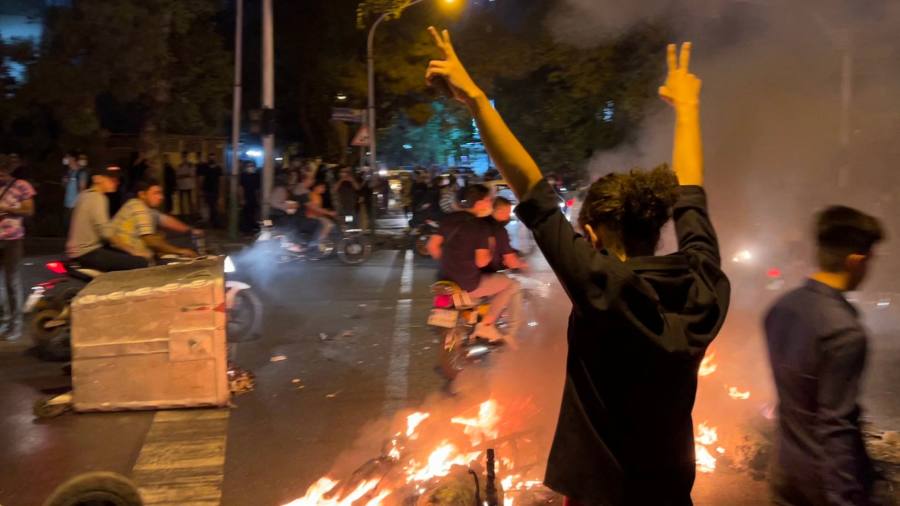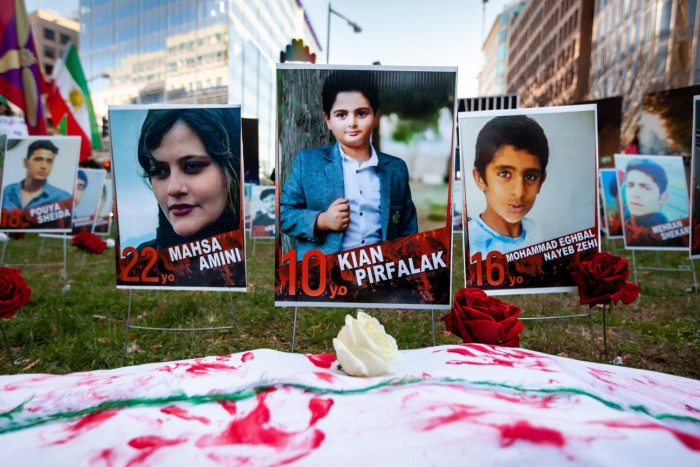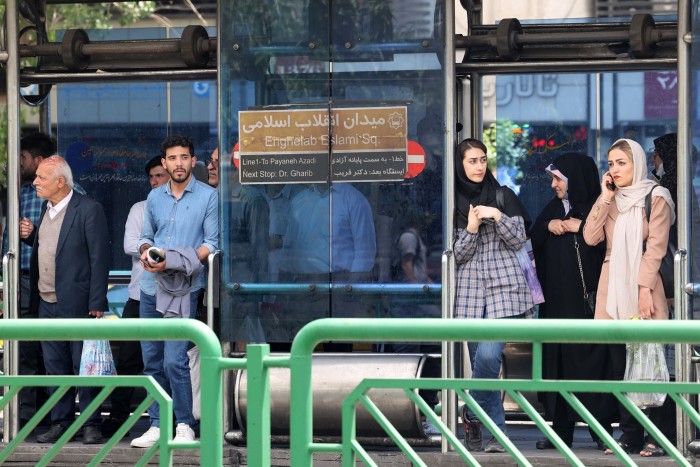
Receive free Iran updates
We’ll send you a myFT Daily Digest email rounding up the latest Iran news every morning.
The huge protest movement last year that posed the most significant threat to the Iranian regime in decades has abated — for now. But for those who lost loved ones or risked their lives during the brutal security response, the act of defiance goes on.
From celebrating the lives of family members killed amid the demonstrations to women defying Iran’s strict hijab rules and allowing their hair to flow, small acts of non-violent resistance are an everyday reminder to the authorities from those determined to keep the spirit of “Woman, Life, Freedom” alive.
“I check the social media posts from the families of the victims every day, they make my heart ache,” said Mona, a 22-year-old personal trainer, adding that she was “in awe” of the “superhuman beings who cannot be silenced.”
There are risks for those who refuse to let the regime forget. Last month, the family of Abolfazl Adinehzadeh, a teenager who was killed in October at the height of the protests, wanted to mark what would have been his 18th birthday by throwing a party by his grave. The public were invited to join in. But when the security forces heard about the event, in a village in the north-east of the country, they moved in the night before to arrest family members.
Yet, in a show of solidarity, others picked up the baton and celebrated Adinehzadeh’s life via comments and videos on social media. Relatives of Erfan Khazaei, a Kurdish man who also died during the demonstrations, went a step further by placing a cake with black candles and red balloons on the teenager’s grave.
“The families who seek justice will always support each other,” Khazaei’s sister said in a video posted online.
In another high-profile case, Mahmonir Molaei-Rad, whose young son Kian was killed in disputed circumstances last year, has found herself at the centre of the storm after pledging to commemorate the day he would have turned 10.
But the event turned into a nightmare as security forces arrived and shot her cousin dead, claiming he had killed a policeman during the protests.

Compounding her anguish, the authorities have continued to insist that Kian was killed by a man who has since been taken into custody, while Molaei-Rad has blamed the security forces for his death. In another twist, she has since disappeared from social media, with her Instagram account deactivated.
More than 300 people, including at least 41 children, were killed in the brutal crackdown that accompanied more than three months of demonstrations across Iran last year, according to Amnesty International.
The protests, one of the biggest challenges to the regime since the 1979 revolution, were sparked by the death in police custody of 22-year-old Mahsa Amini in September after her arrest for allegedly failing to observe the Islamic dress code.
Although protesters are no longer taking to the streets, acts of rebellion continue every day, including by women inspired by Mahsa to shun the headscarves and long shirts they were once obliged to wear in public. Some have gone even further during Tehran’s hot summer, exposing their midriffs and legs.
The regime has been uncompromising over any activities that they believe could risk reviving the street protests, such as anti-regime gatherings. But it appears to have accepted that some will opt out of the hijab while in public, although businesses still face consequences if they allow women to do so on their premises.
For now, a lack of consistency and transparency over the rules is leaving room for interpretation. When the art faculty at Tehran University obliged female students to wear tight scarves to fully cover their hair, they refused.
“Every morning, when I go to work without wearing my scarf, I feel I’m continuing our struggle for freedom,” said Delara, a 32-year-old businesswoman. “We may not be chanting slogans in the street but walking outside without a hijab is no less than that.”

Actions such as this appear to be having an impact, with some of Iran’s hardline elements accepting the need for social — if not political — change. While many conservatives are uneasy with the liberalisation that has followed the protests, others have backed the push for greater social freedom as a way to ease public dissent at a time when people are emotionally scarred by the unrest and struggling with economic hardship.
Javan, a newspaper close to the hardline Revolutionary Guards, wrote last month that the Islamic republic was wrong to be so tough on women over the hijab, and even said that Iranian society lacked joy.
“The authorities just don’t want to admit they’re quietly opening up,” said a conservative journalist. “In two years’ time, we won’t have such discussions about hijab anymore,” he added. But he also believed that the regime was concerned about losing the support of ideologically driven hardliners who have urged authorities to enforce hijab laws.
On the other side are those Iranians who are determined that the injustices that drove them on to the streets will not been forgotten. “What are you going to do with the memories and names of those heroes who are in the hearts of millions of Iranians?” Kamelia Sajadian, another mother who lost a son, pleaded to the regime.
“Every day is the birthday of one of those heroes . . . who raised the flag of justice with their blood,” she wrote on Instagram. “I grab this flag and push ahead with all my strength.”